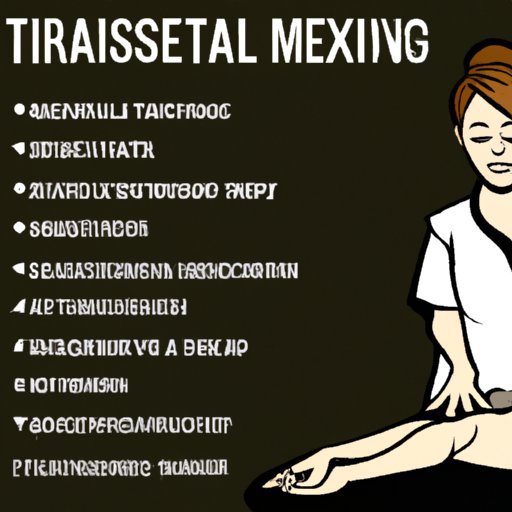Introduction
Massage therapy is a form of healing that involves manipulating the body’s muscles and soft tissues. It has become increasingly popular in recent years, with many people seeking out massage therapy for relaxation, pain relief, and improving overall health and wellness. Becoming a massage therapist requires specialized training and certification, as well as an understanding of the different types of massage therapy and their benefits. In this article, we will explore how to become a massage therapist, including educational and licensing requirements, types of massage therapy, and tips for establishing a successful practice.
Educational and Licensing Requirements
Before you can become a massage therapist, you must first complete the necessary education and obtain the required licensing or certification. Most states require massage therapists to have a minimum of 500 hours of massage therapy training from an accredited school. Some states may also require additional continuing education credits, depending on the type of massage therapy being practiced. Additionally, you may need to pass a state-administered exam to earn your license.
“In order to be successful in this field, it’s important to have a solid foundation in the science and art of massage therapy,” says Dr. John Kitzmiller, a licensed massage therapist and professor at the American Institute of Massage Therapy. “It’s essential to understand anatomy, physiology, kinesiology, and pathology, as well as the therapeutic effects of massage.”
Types of Massage Therapy
There are many different types of massage therapy, each with its own set of techniques and benefits. The most common types of massage therapy include Swedish massage, deep tissue massage, sports massage, prenatal massage, and shiatsu.
Swedish massage is the most popular type of massage, and is known for its gentle, relaxing strokes. It is often used as a form of stress relief and to help improve circulation. Deep tissue massage is a more intense form of massage therapy that focuses on the deeper layers of muscle tissue. It is often used to treat chronic pain and tension. Sports massage is designed to help athletes prepare for physical activity and recover from workouts. Prenatal massage is specifically designed to help pregnant women reduce discomfort and relax. Shiatsu massage is based on traditional Japanese massage techniques and focuses on applying pressure to specific points on the body.
Benefits of Massage Therapy
Massage therapy offers numerous benefits, both physical and mental. Physically, massage therapy can help reduce pain, improve range of motion, reduce stress and tension, and improve circulation. Studies have also found that massage therapy can help reduce anxiety and depression, and improve sleep quality. A study conducted by the National Institutes of Health found that massage therapy was effective in reducing symptoms associated with depression and anxiety.
“Massage therapy can be an incredibly powerful tool for improving physical and mental wellbeing,” says Dr. Kitzmiller. “It can help reduce stress and tension, improve circulation, and even reduce pain.”
Career Paths
Once you have completed your education and obtained the necessary licensing, you can begin your career as a massage therapist. There are several career paths you can take, including setting up your own practice, working in a spa or clinic, or working in a hospital or other medical setting. Each path offers its own unique set of rewards and challenges.
If you decide to set up your own practice, you will be responsible for everything from marketing and networking to setting rates and managing expenses. Working in a spa or clinic can provide stability and a steady income, while working in a medical setting can give you the opportunity to work alongside other healthcare professionals and gain valuable experience.
Communication Skills
Communication skills are essential for any massage therapist. You must be able to establish trust with clients and ask questions to better understand their needs. Developing a therapeutic relationship with your clients is key to providing them with the best possible experience. Listening carefully to your clients and responding to their needs is also essential.
“The ability to listen and truly understand what your clients are looking for is one of the most important skills a massage therapist can have,” says Dr. Kitzmiller. “It’s important to be able to connect with your clients on an emotional level and create a comfortable, safe environment.”
Financial Aspects
When setting up your own practice, it’s important to consider the financial aspects of running a business. You will need to determine your pricing structure, set rates for your services, and manage expenses such as rent, insurance, and supplies. You should also factor in taxes and other costs associated with running a business. It’s important to research the market and understand what other massage therapists in your area are charging before setting your own rates.
Tips for Establishing a Successful Practice
Establishing a successful practice takes time, effort, and dedication. Here are some tips for getting started:
- Develop a comprehensive marketing plan to reach potential clients.
- Build a strong client base by offering discounts, referrals, and loyalty programs.
- Network with other massage therapists, physicians, and healthcare providers.
- Stay up-to-date on industry trends and techniques.
“Creating a successful practice takes hard work and dedication,” says Dr. Kitzmiller. “It’s important to invest in yourself and stay current with the latest trends and techniques.”
Conclusion
Becoming a massage therapist requires specialized training and certification, as well as an understanding of the different types of massage therapy and their benefits. It’s important to understand the educational and licensing requirements, as well as the communication and financial aspects of running a business. With the right knowledge and skills, you can become a successful massage therapist and enjoy the many physical and mental benefits of this rewarding career.
(Note: Is this article not meeting your expectations? Do you have knowledge or insights to share? Unlock new opportunities and expand your reach by joining our authors team. Click Registration to join us and share your expertise with our readers.)
